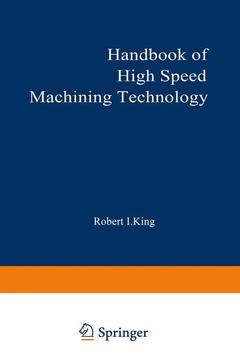Description
Handbook of High-Speed Machining Technology, 1985
Chapman and Hall Advanced Industrial Technology Series
Author: King Robert
Language: English
Keywords
cutting; design; grinding; laser; machine; machining; management; manufacturing; metals; planning; production; technology
Publication date: 11-2012
472 p. · 15.5x23.5 cm · Paperback
472 p. · 15.5x23.5 cm · Paperback
Description
/li>Contents
/li>
The United States now spends approximately $115 billion annually to perform its metal removal tasks using conventional machining technology. Of this total amount, about $14 billion is invested in the aerospace and associated industries. It becomes clear that metal removal technology is a very important candidate for rigorous investigation looking toward improvement of productivity within the manufacturing system. To aid in this endeavor, work has begun to establish a new scientific and technical base that will provide principles upon which manufacturing decisions may be based. One of the metal removal areas that has the potential for great economic advantages is high-speed machining and related technology. This text is concerned with discussions of ways in which high-speed machining systems can solve immediate problems of profiling, pocketing, slotting, sculpturing, facing, turning, drilling, and thin-walled sectioning. Benefits to many existing programs are provided by aiding in solving a current management production problem, that of efficiently removing large volumes of metal by chip removal. The injection of new high-rate metal removal techniques into conventional production procedures, which have remained basically unchanged for a century, presents a formidable systems problem, both technically and man agerially.The proper solution requires a sophisticated, difficult process whereby management-worker relationships are reassessed, age-old machine deSigns reevaluated, and a new vista of product/process planning and design admitted.
One General Theory.- 1 Historical Background.- 2 Cutting Theory and Chip Morphology.- 3 Machine Dynamics.- 4 Cutting Fluids in Industry.- Two Turning.- 5 Turning.- Three Milling.- 6 General Theory and Its Application in the High-Speed Milling of Aluminum.- 7 Machine System Design and Performance.- 8 Operational Data.- Four Drills and Drilling.- 9 Introduction to Part Four.- 10 A Mathematical Model for Drill Point Geometry.- 11 Microcomputer-Controlled Seven-Axis Drill Point Grinder.- 12 Drill Analyzer.- 13 Multifacet Drills.- 14 An End Effector for Robotic Drilling.- Five Grinding.- 15 Grinding.- Six Laser Applications.- 16Laser Applications.- Seven General Management Considerations.- 17 General Management Considerations.- 18 Factory Models.- 19 Economic Models for Process Development.- 20 Quality Control Circles: The Key to Employee Performance Improvement.- 21 Leadership: The “Right Stuff” for Management of Human Productivity.
© 2024 LAVOISIER S.A.S.
These books may interest you

Metal Cutting Theory and Practice 281.07 €

Metal Cutting Theory and Practice 111.58 €


